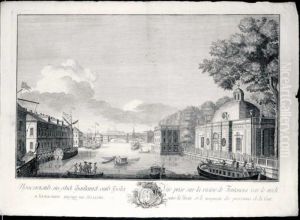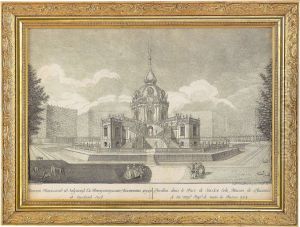Mikhael Ivanovich Makhaev Paintings
Mikhael Ivanovich Makhaev was a distinguished Russian engraver of the 18th century, born in 1718 and passing away in 1770. His work is particularly noted for its intricate detail and for providing a valuable visual record of urban and architectural developments in Russia during his lifetime. Makhaev's contributions are especially significant in the context of the cultural and architectural transformations that Russia underwent during the reign of Empress Elizabeth and into the era of Catherine the Great.
Makhaev's most celebrated works are his engravings of Saint Petersburg, which offer a meticulous depiction of the city's evolving landscape. These works were not only artistic achievements but also served as important historical documents, capturing the grandeur of the city's architecture and urban planning. Among his notable projects was the series of views of Saint Petersburg, commissioned by the Empress Elizabeth in the 1750s. This project aimed to showcase the imperial capital's magnificence, reflecting the ambitions of the Russian state to position itself as a major European power.
In addition to urban landscapes, Makhaev was involved in creating engravings for books, further illustrating his versatility as an artist. His technique and attention to detail were highly regarded, contributing to the dissemination of Russian architectural and scenic beauty beyond the country's borders. Despite the fact that many of his original engravings are now valuable collectors' items, Makhaev's work continues to be a significant source for historians and art historians alike, offering insights into the aesthetic and cultural aspirations of 18th-century Russia.
Makhaev's legacy is that of a master engraver whose work encapsulates a pivotal moment in Russian history. Through his engravings, one can trace the architectural evolution of Saint Petersburg and gain a deeper understanding of the cultural ambitions of the Russian Empire during an era of profound change. His death in 1770 marked the loss of a major figure in Russian art, but his contributions live on, celebrated for their historical value and artistic excellence.

